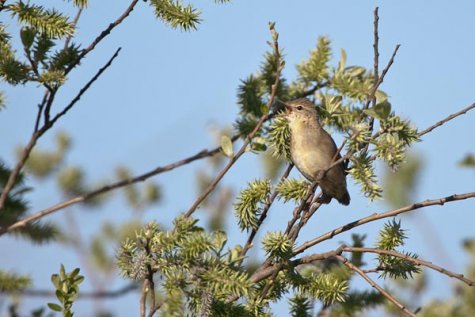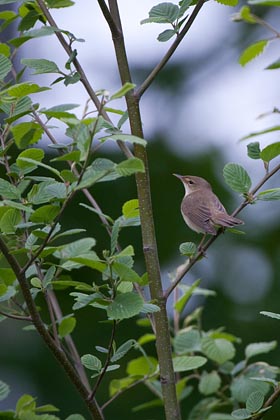Birder's diary - 18 - 19.05 and 20.05
Birder Margus Ots, Linnuvaatleja.ee
Photos: Arne Ader
Translation: Liis
Black-throated loon
May 18th
Although I was badly tired I got up early and was at the Virtsu lighthouse at 5.30 to watch. I should have been there at least half an hour earlier because the sky was filled with birds already. Branta geese, scoters, long-tailed ducks and loons were flying in several layers and alone it was impossible to check all overflying birds “face-to-face”. During three hours I counted more than 10000 barnacle geese (Branta leucopsis), all coming from the Saaremaa direction and heading for north-east. It was interesting to observe the parasitic jaegers’ (Arctic skuas’) (Stercorarius parasiticus)activities. At least 6 birds were stationary and harassed the terns and gulls in order to rob them of their prey of fish. In addition at least 26 parasitic jaegers were passing on migration. Loons were moving nicely too (black-throated loon (Gavia arctica)and red-throated loon (Gavia stellata)), I managed to count 528 of them. Among the loons I found today’s rarity too. Observing a scoter flock by telescope a large loon suddenly came into view, with a light collar at its dark neck; the large and white beak particularly caught the eye. It was immediately clear that we had to do with a yellow-billed loon (Gavia adamsii), a rare passing migrant here. I followed it in the telescope until the bird disappeared far into the north. After the misfortunes yesterday a slight twitcher’s depression had already been settling in, now I was again full of energy and ready for new trips. The yellow-billed loon was the 247th bird species on my 2012 year list
Greater scaups
In the evening I finally reached Cape Põõsaspea where I joined a larger company to observe the migration. A few hours before sunset flocks of greater scaups (Aythya marila) gradually began to fly past and a hope grew that it might again be a good migration evening but unfortunately it did not turn out that way. We counted about 5200 greater scaups but would have expected a many times greater number.
Grasshopper warbler
May 19th – 250 bird species attained!
In the morning I stayed watching for a couple of hours at Cape Põõsaspea. Although comparatively many loons were moving (about 700), no particularly interesting creature was to be seen. Only a few hundred other waterfowl were migrating. After that I decided to move slowly towards south and look for birds of prey on the road. The first new species for the day I got from the Rooslepa village meadow where a grasshopper warbler (Locustella naevia)was chirping. In the Kastja village hayfield I finally got the corn crake listed. The bird has already been here for several weeks but because I have been for a long time at Ristna and elsewhere on the western coast where this species isn’t heard I only got the crake noted now.
On the lands of Märjamaa parish a spotted eagle caught my eye: it had broader wings than a lesser spotted eagle (Aquila pomarina), the 7th “digit“ was clearly discernible and the wing coverts were dark and not light as for the lesser spotted eagle. Other details in the wing pattern too suggested that according to characteristics to my knowledge this creature could be identified as greater spotted eagle (Aquila clanga). Unless it was a spotted eagle hybrid that regrettably occur here, but cannot always be separated from a pure individual only on the evidence of plumage. The greater spotted eagle was the 250th bird speciesin my 2012 species list.
In the evening I already headed for the Pikla ponds on the southwestern coast where last night a little bittern (Ixobrychus minutus) was reported to have been seen. Because the available information was somewhat muddled I didn’t know what to think of the observation to start with. According to information at the Rarity committee the little bittern has been seen in Estonia only 13 times and the last time was in 1992. Late last night the whole area had been carefully inspected but the little bittern was not found again We have to do with a bird with a secretive way of life that one seldom succeeds to see, rather the characteristic “bellow” can be heard. But the finders of the bird happened to be watching in the same spot this night too and some questions were asked about the find. It turned out that the bird had risen in flight in front of the watching tower and flown a little further into a reed tuft. Some ten minutes later the bird was found again for a moment by telescope searching, but it was not seen further. Based on the conversation and description it really seemed to have been a little bittern. I myself searched several hours for the bird, but I hadn’t much hope of finding it because the reed stands at Pikla are several square kilometres large: you won’t find a needle in a haystack. No call was heard either although we tried to decoy it for some time.
The last new species of the day I found late in the evening in Häädemeeste village where a river warbler (Locustella fluviatilis)was singing. My 2012. year list now has 251 bird species.
Marsh warbler
May 20th
The original plan was to go out at once again to Pihkva early in the morning but the extremely long days of last week had done their work and the alarm clock went unheard. One longer sleep was really needed now. At midday I searched for a few hours in Pikla but nobody much was to be seen. A cow flock that tried to scramble on a car was rather more interesting. Some jokers had parked their car in a cattle field and about ten cows were polishing the window glasses nicely “clean“ with their tongues and the car was hit by other fluid and less fluid matter here and there as well. Some tried too to test the strength of the mirrors and the metal with their horns. It all reminded very much of the Kusturica film „Black cat, white cat“ where a pig gobbled up a Trabant. Fortunately things did not get as drastic here and after some washing the car should have its original looks back.
Because I have business matters to attend to in Tartu for some days in the beginning of the week I headed for home again for the first time in a long period. In the Timmkanali and Laiksaare forests I made a couple of stops and as the only new species for the day I got the marsh warbler (Acrocephalus palustris). My 2012 list now has 252 bird species.
In the evening I made a longer stop at the Valguta polder, where the great number of cormorants (Phalacrocorax carbo) was notable. Together with Hannes Margusson, whom I happened to meet at the polder, we estimated the number of cormorants at about 250, but in the evening they could already be counted to more than 300. Among more interesting creatures 3 white-winged terns (Chlidonias leucopterus)and 15 great egrets (Egretta alba) could be seen.











